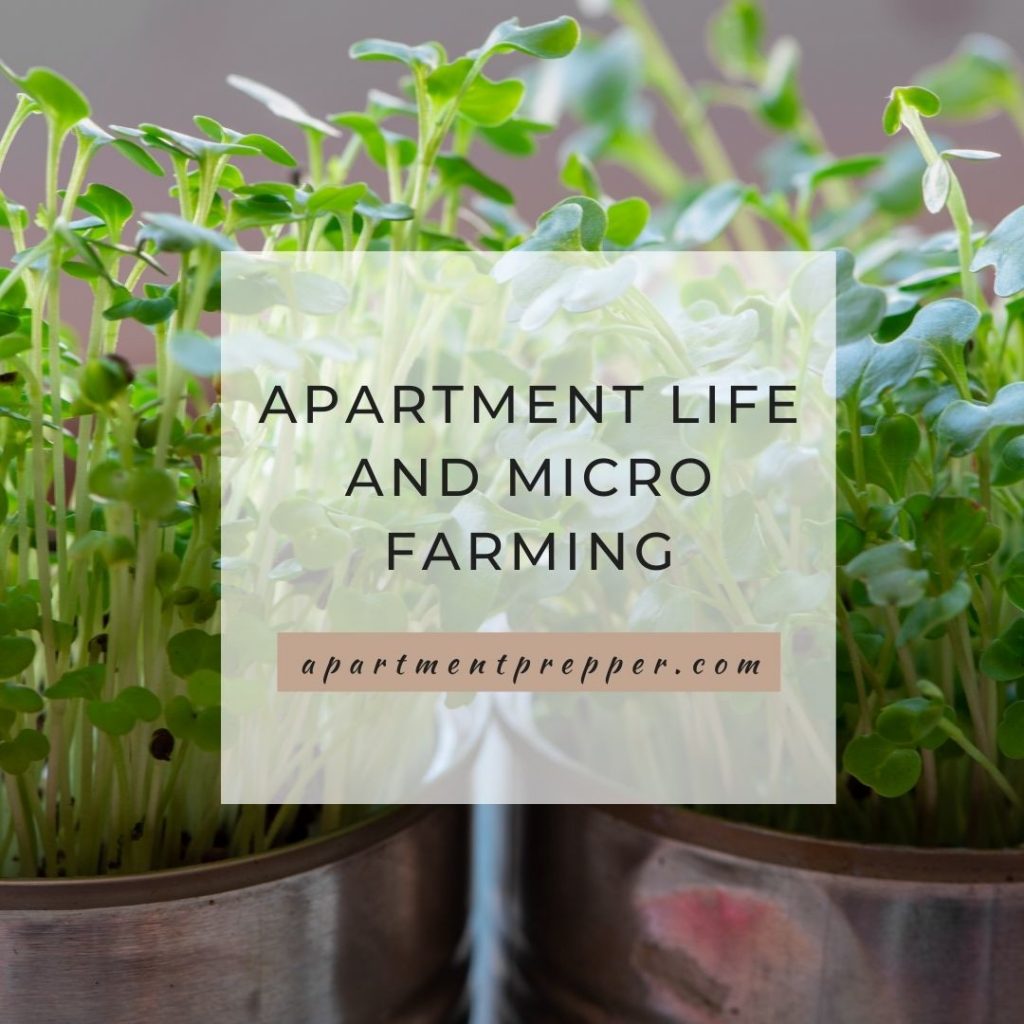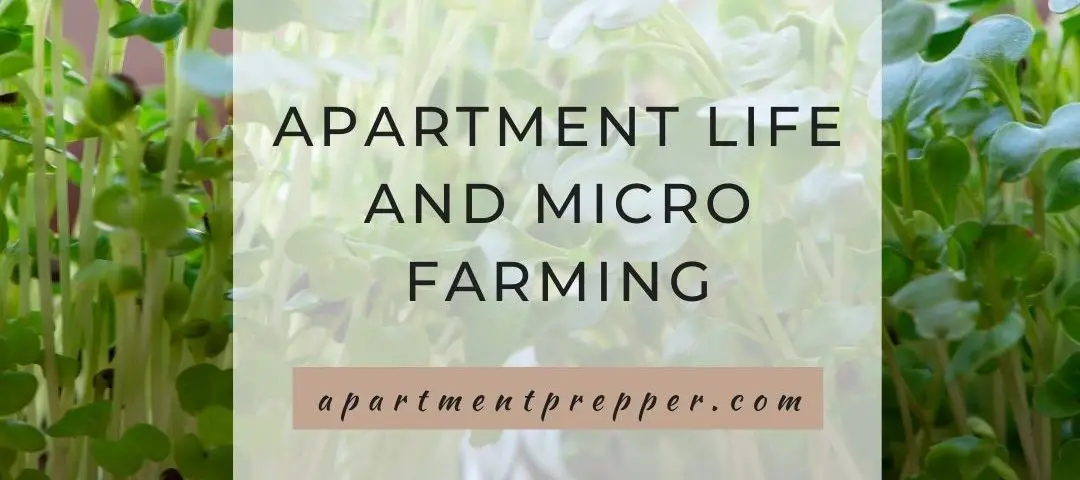Written by Aden Tate
The ideal prepper’s retreat would be a 40+ acre ranch/orchard out in the middle of nowhere. Unfortunately, in life the ideal rarely happens. For many of us, living in an apartment is our only option at the moment, whether that be due to work, family, or whatever. And though at first glance it would seem that those who live in apartments will never be able to produce their own food, that is simply not true.
While an apartment dweller will never be able to grow enough food for their own daily consumption, that doesn’t mean that they won’t be able to produce something. And in a survival situation, something is most certainly better than nothing. Prepping is about layers. It’s about adding layers of security, layers of buffering between the point of impact of a disaster on one end and us on the other. All preppers should start a food storage plan that should include stocking a pantry and possibly buying freeze-dried foods.
Producing our own food, even if it’s only a small amount of our total consumption is the addition of one of these layers. It helps to stretch our stored food supplies in the event of a disaster, allows us some form of barter, provides a sense of confidence, and gives us a strong step up on being food independent.
So, what are some of the ways that an apartment dweller can produce food, adding to his total layering of disaster preparedness? Let’s take a look:
Microgreens
I learned about growing my own microgreens after reading through an article in Mother Earth News several years ago. In essence, they’re the small little shoots of plants. Aside from being incredibly nutritious and easy to grow, they also taste great as well, and microgreens comprise the majority of the salads that I eat nowadays.
Here is how it works. I grow black oil sunflowers and broccoli sprouts for my microgreens. I bought three bread tins at the Dollar Store and filled them up with garden soil. I put two tablespoons of sunflower seeds and around a half a tablespoon of broccoli seeds into their own separate glasses full of water. I then let the seeds soak in those glasses of water for 24 hours. After 24 hours, I spread the seeds evenly on top of the dirt in each tin. I keep the sunflower and broccoli seeds separated from each other. I then cover the tins with newspapers (to keep the light out), and water the sprouts every morning just a bit. The sprouts will push up the newspaper about 7 days later.
I then remove the newspapers when the sprouts are around three inches high. Another day or two of exposure to sunlight, and the yellow sprouts will turn green. Then I clip them and eat them. It’s an incredibly easy process that can allow you to grow gallons of salad with minimal effort throughout the year.
Mushroom Bags
When it comes to growing mushrooms, I highly recommend Fungi Perfecti. As far as I’m concerned, they are hands down the golden standard when it comes to quality spawn. Paul Stamets – the owner – is a genius when it comes to mycology. Tradd Cotter has a wonderful book on the subject as well, called Organic Mushroom Farming and Mycoremediation that delves into this topic at length. In his book, Cotter goes into detail of what it takes to grow your own mushrooms inside safely. Mushrooms can be incredibly prolific, and just one gallon of substrate prepared for oyster mushrooms can produce around 1.75 pounds of fruiting bodies per week, according to the book. That equates to about 91 pounds of mushrooms per year.
Windowsill Plants
Most windowsill gardens that I’ve seen involve herbs of some form. Though herbs are most certainly not a significant source of calories, there are plenty of herbs out there with medicinal qualities that could serve you well in a grid-down type situation. And if that’s not something you’re really in to, you can always spice up your food with them!
Microtrees
Just about any seed catalog out there will sell some variant of a micro tree. You can buy your own miniature orange, lime, and banana trees. These small trees can easily fit into the corner of a room where they will not only serve as décor but will also produce small amounts of food.
Patio Container Gardening

This is the low hanging fruit here (no pun intended). A lot of apartments out there have some form of back deck attached to them. Obviously, a small amount of food could be grown in pots out on these decks (depending upon the amount of sunlight that they receive. Beets, leafy greens, chard, and spinach are just some of the plants that will do alright in a partially shady area.
Hanging Tomato Baskets
Within an apartment setting, it’s difficult to find the space to actually grow tomatoes. Hanging baskets are a common household fixture however, and now that there are hanging tomato baskets, there’s no reason why hanging tomatoes could not be grown indoors within an apartment setting. [insert link:
Vertical Gardening
You would really have to have a back deck or patio of some sort with plenty of sun exposure for this to work and not look ridiculous. I personally don’t think that the gigantic vertically placed PVC pipes full of dirt are very aesthetically pleasing, so I would shy away from those myself. A trellis with a runner bean, gourds, or sweet potatoes planted in a pot right by the door would not only provide you with a source of food, but it would look good as well. That’s what I would recommend here. However, if you are a bit more gear inclined, you may want to check out products such as this hanging vertical garden.
Kale/colored leaf lettuce
The cool things about both of these plants is that they can be incredibly decorative. Odds are you’ve seen kale used in landscaping around peoples’ houses before and not even realized it. Both of these plants are incredibly easy to grow, don’t take up a lot of space, and just look pretty. You can end up with a new harvest in as little as 30 days with lettuce as well, making these nice additions to apartment farming.
Harvesting the Fruits of Our Talk
No, I think I can say with a degree of certainty that you’ll never be able to grow enough food in your apartment for you to live off of without turning your entire home into a veritable jungle. However, that doesn’t mean that you can’t grow some of your own food while still keeping your home a home (rather than an expensive greenhouse. Hopefully, the above points will give you some food for thought (I didn’t mean this pun either) as you contemplate ways to improve your own food security.
Are there other options that you’ve found? Let us know in the comments below!
About the Author:
Aden Tate is the author of The Faithful Prepper.
We are an affiliate of Amazon.com, which means we received a small commission if you click through one of our Amazon links when you shop, at totally no cost to you. This helps keep the lights on at the blog. Thanks!




We re-grew green onions by cutting off just the white part with the roots at the bottom of the bunch, and got two months worth of green onions for free, in a small pot. Just cut a handful when you need them and they will keep growing. If you have a dehydrator you can grow and dry enough for bean seasoning all year in a very small space.
Thanks for all the salad tips; I grow cat grass indoors for my kitty so growing people greens shouldn’t be much different. It’s decorative and useful all at once, and if things look decorative even the pickiest neighbors don’t complain.
Hi Aunt Mary, Thanks for the ideas! I appreciate them!